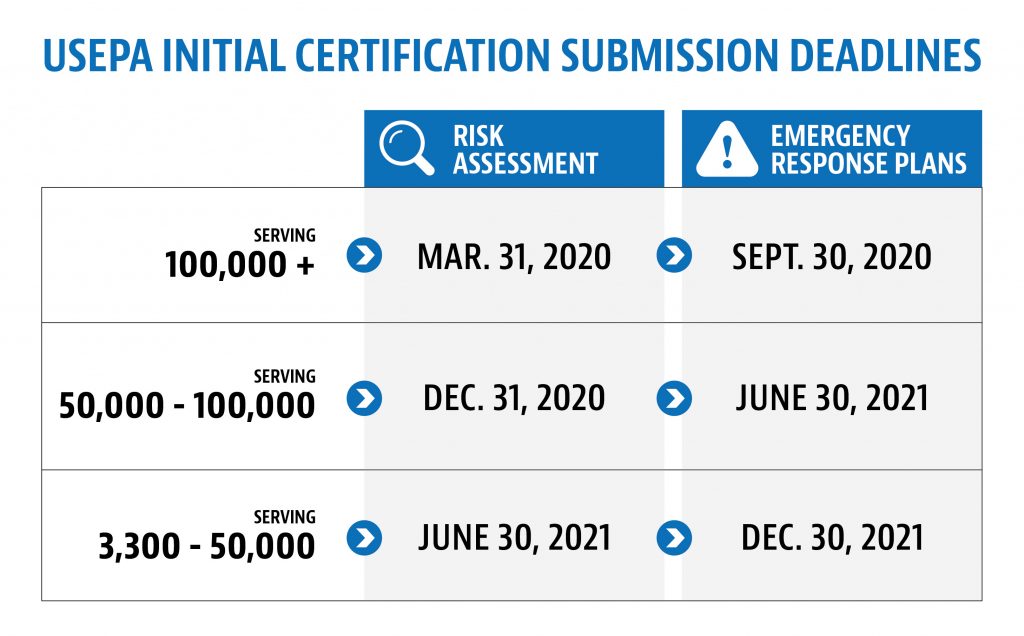The benefits of America’s Water Infrastructure Act (AWIA) include it is holistic and encompasses many risks that could pose a threat to a community’s water supply, and it seeks to prevent and mitigate those risks by protecting the nation’s water infrastructure. AWIA expands on the Bioterrorism Act of 2002 to ensure Risk and Resilience Assessments and Emergency Response Plans account for a multitude of potential harmful scenarios.
AWIA is a great opportunity for water utilities to update their Risk and Resilience Assessments and incorporate those findings into their Emergency Response Plans, so the communities are better prepared for whatever obstacles arise. Adam Zach, AE2S Project Engineer and Emerging Regulatory Issues Specialist, points out that AWIA compliance benefits include, “prevention of large-scale water crises, preparedness in the event of natural disasters, and addressing cybersecurity risks.”
Here are the requirements and deadlines for Risk and Resilience Assessments, as well as Emergency Response Plans under AWIA.
Risk and Resiliency Assessments
AWIA requires that Risk and Resilience Assessments account for the following components:
- Malevolent acts such as vandalism or terrorism.
- Natural hazards.
- Resilience of pipes and constructed conveyances, physical barriers, source water, water collection and intake, pretreatment, treatment, storage and distribution facilities, electronic, computer, or other automated systems (including the security of such systems) which are utilized by the water system.
- Monitoring practices of the system.
- Financial infrastructure of the system.
- Use, storage, and handling of various chemicals by the system.
- Operation and maintenance of the system.
- Optional evaluation of the capital and operational needs for risk and resilience management for the system.
Community water systems are able to use existing Risk Assessments and Emergency Response Plans if they comply with the criteria laid out in AWIA.
Emergency Response Plans
No later than six months after certifying completion of its Risk and Resilience Assessment, each system must develop or revise the Emergency Response Plan. Water utilities must coordinate with local emergency planning entities when preparing response plans. Under AWIA, these Emergency Response Plans should include:
- Strategies and resources to improve the resilience of the system, including the physical security and cybersecurity of the system.
- Plans and procedures that can be implemented, and identification of equipment that can be utilized, in the event of a malevolent act or natural hazard that threatens the ability of the community water system to deliver safe drinking water.
- Actions, procedures, and equipment, which can prevent or significantly lessen the impact of a malevolent act or natural hazard on the public health and the safety and supply of drinking water provided to communities. Such items include the development of alternative source water options, relocation of water intakes, and construction of flood protection barriers.
- Strategies that can be used to aid in the detection of malevolent acts or natural hazards that threaten the security or resilience of the system.
Another important aspect to consider when reviewing these plans is the crisis communication strategies of the water utilities. What is the chain of command in an emergency? What are the steps? What entity is contacted first? Is there a network connecting water utilities, city officials, and first responders? How and when will the community be notified? Preparedness comes with addressing these and other concerns in the Emergency Response Plan. Every minute matters in a crisis.
Dates and Deadlines
The USEPA’s initial certification submission deadlines for the Risk Assessments and Emergency Response Plans are as follows:

In early August, USEPA will provide further baseline information about relevant potential risk to community water systems. Risk to water systems means that the occurrence would disrupt the system’s ability to provide a safe and reliable supply of drinking water, or that it would otherwise present significant public health or economic concerns to the community served by the system.
Moving forward, be aware of the compliance deadlines for your system and be on the lookout for more details on specific requirements from the USEPA in August. Community Water Systems can take appropriate steps now to make sure they are better prepared for the upcoming requirements, including reviewing existing Emergency Response Plans and Risk Assessments and comparing them to the criteria the USEPA has provided so far.
Contact Nate Weisenburger, AE2S Drinking Water Practice Leader, for guidance on complying with AWIA requirements.

